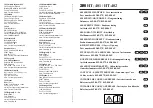
FluoroMax-3 v. 3.1 (6 Mar 2006)
Glossary
13-5
routinely.
Extrinsic fluorescence
Inherent fluorescence of fluorescent probes added to a system to
study non-fluorescent molecules. These probes have gained accep-
tance in a variety of applications.
Filter
An optical element that is used to select certain wavelengths of light.
Types of filters include high-pass, low-pass, bandpass, and neutral-
density.
Flash lamp
A source that provides pulsed light to excite a sample for phospho-
rescence or fluorescence measurements. The repetition rates and time
response of the source determine the useful range of the source for
these measurements. The lamps can be used in either “free running”
or “gated” modes depending on the support electronics.
Fluorescence
The emission of light during the transition of electrons from the ex-
cited singlet state to the ground state from molecules originally ex-
cited by the absorption of light. Fluorescence typically occurs within
~10
–9
seconds.
Fluorescence lifetime (
τ
)
The average length of time that a molecule remains in the excited
state before returning to the ground state.
Fluorophore (fluorescent
probe)
A molecule or compound that has a known fluorescence response.
These probes have various sensitive areas depending on the peak ex-
citation and emission wavelengths and their fluorescence lifetimes.
Fluorophores are used to provide information on concentration, size,
shape, and binding, in a particular medium. Good fluorophores are
stable over wide pH and temperature ranges.
Front-face detection
A mode of detection in which fluorescence is collected off the front
surface of the sample. Front-face detection is usually selected for tur-
bid samples in solution (e.g., blood), samples of high concentration,
or solid samples such as powders, thin films, pellets, and cells on a
coverslip. Front-face detection collects fluorescence off the sample at
a 22.5° angle to minimize reflections and scattering.
Grating
An optical element in a monochromator that uses finely-etched verti-
cal grooves to disperse incident light into its constituent wavelengths.
Reflection gratings (grooves etched on a highly reflective surface)
are used in the FluoroMax
®
-3. Gratings are scanned by rotating their
optical centers about the optical axis of the instrument, with the inci-
dent angle of the entrance beam determining the wavelength of light
directed to the exit aperture. Gratings come in a variety of formats
and are commonly made by physically
ruling
(scribing) the grating,
or holographically
etching
the grating grooves.
Ground state (S
0
)
The lowest energy level in a molecule. For fluorescence to occur, a
molecule absorbs a photon of light, thereby exciting it to the S
1
level.
A fluorescence emission occurs during a transition from an excited
state S
1
to the ground state S
0
.
Содержание FluoroMax-3
Страница 5: ...FluoroMax 3 v 3 1 3 Mar 2006 v 15 Declaration of Conformity 15 1 16 Index 16 1...
Страница 6: ...FluoroMax 3 v 3 1 3 Mar 2006 vi...
Страница 18: ...FluoroMax 3 v 3 1 3 Mar 2006 Introduction 0 12...
Страница 36: ...FluoroMax 3 v 3 22 Feb 2005 System Description 2 8...
Страница 96: ...FluoroMax 3 v 3 1 3 Mar 2006 Maintenance 6 12...
Страница 156: ...FluoroMax 3 v 3 1 6 Mar 2006 Automated Polarizers 10 22...
Страница 208: ...FluoroMax 3 v 3 1 6 Mar 2006 Bibliography 14 4...
Страница 210: ...FluoroMax 3 v 3 1 6 Mar 2006 Declaration of Conformity 15 2...
Страница 220: ...FluoroMax 3 v 3 1 25 Apr 2006 Index 16 10...
















































